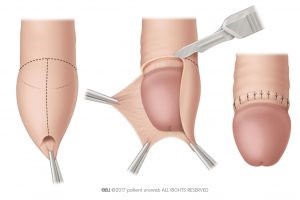Treating pre-cancerous conditions of the penis
The names or terms used to describe pre-cancerous lesions can be confusing. The correct medical term is PeIN (Penile Intraepithelial Neoplasia) but there may be other names that the
medical team may use such as Bowenoid papulosis or Erythroplasia of queryat. Penile intraepithelial neoplasia (PeIN) is a condition where abnormal cells grow on the skin of the penis, and it comes in two types: differentiated and undifferentiated. Differentiated PeIN often happens due to long-term skin irritation and is less likely to turn into cancer. Undifferentiated PeIN is usually related to certain HPV infections, which can make it more likely to become cancerous if not treated. Knowing the type helps doctors choose the best approach to manage it.
Topical Treatment (creams)
Chemotherapy -5-fluorouracil (Effudex™)
This is a type of chemotherapy cream which is applied to the penis for around 4 – 6 weeks. Chemotherapy works by destroying pre-cancerous cells but may also affect some healthy cells on the penis. This may cause soreness and inflammation which can often be treated with steroid (anti-inflammatory) creams. Inflammation and soreness can last for a few months. This type of chemotherapy will not cause hair loss.
Immunotherapy -Imiquimod cream (Aldara™)
Unlike chemotherapy, immunotherapy stimulates the body’s immune system to fight and regress pre-cancerous cells. It can be used as a treatment on its own or after chemotherapy cream. Treatment is usually applied for 4 – 6 weeks.
You may need to use a barrier cream to protect areas around the penis with both of the above treatments.
Surgery
Sometimes the following treatments may also be suitable for treating very early penile cancer. Information on other types of surgery can be found here
Circumcision
This is the surgical removal of the foreskin and may be appropriate if only the foreskin has been affected by a cancerous or pre-cancerous condition.

Wide local excision
Cancerous tissue will be removed from the penis and a few millimetres of healthy tissue will also be removed to reduce the possibility of any cancerous cells from being left behind.
Mohs microsurgery
This is a technique which may be used for some types of penile cancer. Small slices of cancerous tissue are removed and examined under a microscope. This is repeated until all of the cancerous tissue has all been removed. It is very rare in the UK.
After minor surgery
- There will be a surgical dressing covering the penis. This can usually be removed after about 24 hours. Stitches (sutures) will be dissolvable but can take up to 2 weeks or more to fully dissolve.
- You can wear soft underwear with a loose wound pad over the wound for protection.
- You can shower, normally after 24 hours, but it is important not to rub soap on the penis. It should be dried by gently patting the area with a clean towel or gauze pad. You can have a bath after one week providing the area is healing but should avoid perfumed wash products until the area has fully healed. Moisturising skin care wash (emollient) which does not contain chemicals that may irritate the skin, can often help protect the area.
- The penis will be bruised and swollen after surgery. Painkillers should be taken as prescribed on a regular basis until the wound feels comfortable.
- Although these are minor procedures, you should try and reduce your activity for a few days. You should be able to return to work within a week.
- You can resume sexual activity again after four weeks if it feels comfortable to do so.
Cryotherapy
This technique uses liquid nitrogen at a temperature of between -20° C and -50° C to freeze and kill pre-cancerous cells. The skin on the penis will blister and peel and the procedure may leave a small scar.
Laser ablation
Laser therapy is the use of a very powerful beam of light to kill pre cancerous cells. Laser surgery can be used to destroy pre-cancerous cells. This can cause some minor pain and bleeding and it may take 2–3 months after treatment for the penis to heal fully.
Photodynamic therapy
This is a newer treatment. Light sensitive chemicals are applied to the penis and left for a few hours. A special type of light is then shone at the area which can cause pre-cancerous cells to die.

Reviewed November 2023
